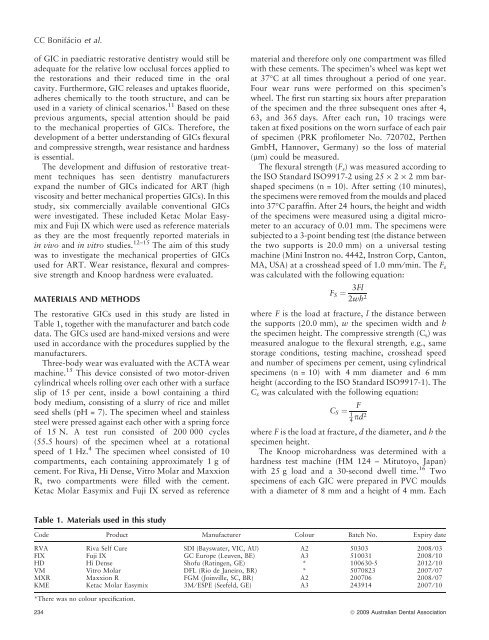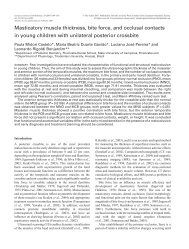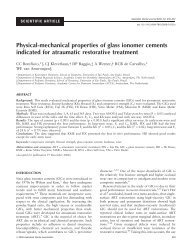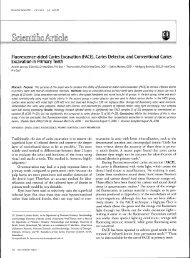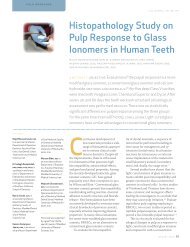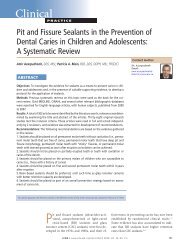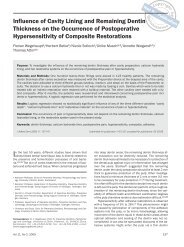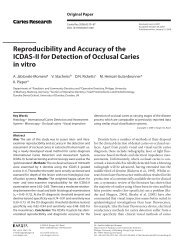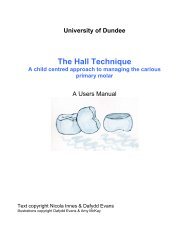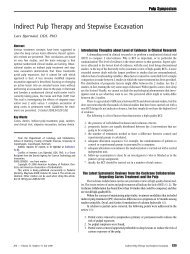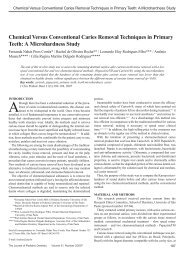Physical-mechanical properties of glass ionomer cements indicated ...
Physical-mechanical properties of glass ionomer cements indicated ...
Physical-mechanical properties of glass ionomer cements indicated ...
You also want an ePaper? Increase the reach of your titles
YUMPU automatically turns print PDFs into web optimized ePapers that Google loves.
CC Bonifácio et al.<br />
<strong>of</strong> GIC in paediatric restorative dentistry would still be<br />
adequate for the relative low occlusal forces applied to<br />
the restorations and their reduced time in the oral<br />
cavity. Furthermore, GIC releases and uptakes fluoride,<br />
adheres chemically to the tooth structure, and can be<br />
used in a variety <strong>of</strong> clinical scenarios. 11 Based on these<br />
previous arguments, special attention should be paid<br />
to the <strong>mechanical</strong> <strong>properties</strong> <strong>of</strong> GICs. Therefore, the<br />
development <strong>of</strong> a better understanding <strong>of</strong> GICs flexural<br />
and compressive strength, wear resistance and hardness<br />
is essential.<br />
The development and diffusion <strong>of</strong> restorative treatment<br />
techniques has seen dentistry manufacturers<br />
expand the number <strong>of</strong> GICs <strong>indicated</strong> for ART (high<br />
viscosity and better <strong>mechanical</strong> <strong>properties</strong> GICs). In this<br />
study, six commercially available conventional GICs<br />
were investigated. These included Ketac Molar Easymix<br />
and Fuji IX which were used as reference materials<br />
as they are the most frequently reported materials in<br />
in vivo and in vitro studies. 12–15 The aim <strong>of</strong> this study<br />
was to investigate the <strong>mechanical</strong> <strong>properties</strong> <strong>of</strong> GICs<br />
used for ART. Wear resistance, flexural and compressive<br />
strength and Knoop hardness were evaluated.<br />
MATERIALS AND METHODS<br />
The restorative GICs used in this study are listed in<br />
Table 1, together with the manufacturer and batch code<br />
data. The GICs used are hand-mixed versions and were<br />
used in accordance with the procedures supplied by the<br />
manufacturers.<br />
Three-body wear was evaluated with the ACTA wear<br />
machine. 15 This device consisted <strong>of</strong> two motor-driven<br />
cylindrical wheels rolling over each other with a surface<br />
slip <strong>of</strong> 15 per cent, inside a bowl containing a third<br />
body medium, consisting <strong>of</strong> a slurry <strong>of</strong> rice and millet<br />
seed shells (pH = 7). The specimen wheel and stainless<br />
steel were pressed against each other with a spring force<br />
<strong>of</strong> 15 N. A test run consisted <strong>of</strong> 200 000 cycles<br />
(55.5 hours) <strong>of</strong> the specimen wheel at a rotational<br />
speed <strong>of</strong> 1 Hz. 4 The specimen wheel consisted <strong>of</strong> 10<br />
compartments, each containing approximately 1 g <strong>of</strong><br />
cement. For Riva, Hi Dense, Vitro Molar and Maxxion<br />
R, two compartments were filled with the cement.<br />
Ketac Molar Easymix and Fuji IX served as reference<br />
Table 1. Materials used in this study<br />
material and therefore only one compartment was filled<br />
with these <strong>cements</strong>. The specimen’s wheel was kept wet<br />
at 37°C at all times throughout a period <strong>of</strong> one year.<br />
Four wear runs were performed on this specimen’s<br />
wheel. The first run starting six hours after preparation<br />
<strong>of</strong> the specimen and the three subsequent ones after 4,<br />
63, and 365 days. After each run, 10 tracings were<br />
taken at fixed positions on the worn surface <strong>of</strong> each pair<br />
<strong>of</strong> specimen (PRK pr<strong>of</strong>ilometer No. 720702, Perthen<br />
GmbH, Hannover, Germany) so the loss <strong>of</strong> material<br />
(lm) could be measured.<br />
The flexural strength (Fs) was measured according to<br />
the ISO Standard ISO9917-2 using 25 · 2 · 2 mm barshaped<br />
specimens (n = 10). After setting (10 minutes),<br />
the specimens were removed from the moulds and placed<br />
into 37°C paraffin. After 24 hours, the height and width<br />
<strong>of</strong> the specimens were measured using a digital micrometer<br />
to an accuracy <strong>of</strong> 0.01 mm. The specimens were<br />
subjected to a 3-point bending test (the distance between<br />
the two supports is 20.0 mm) on a universal testing<br />
machine (Mini Instron no. 4442, Instron Corp, Canton,<br />
MA, USA) at a crosshead speed <strong>of</strong> 1.0 mm ⁄ min. The Fs<br />
was calculated with the following equation:<br />
FS ¼ 3Fl<br />
2wh 2<br />
where F is the load at fracture, l the distance between<br />
the supports (20.0 mm), w the specimen width and h<br />
the specimen height. The compressive strength (Cs) was<br />
measured analogue to the flexural strength, e.g., same<br />
storage conditions, testing machine, crosshead speed<br />
and number <strong>of</strong> specimens per cement, using cylindrical<br />
specimens (n = 10) with 4 mm diameter and 6 mm<br />
height (according to the ISO Standard ISO9917-1). The<br />
Cs was calculated with the following equation:<br />
CS ¼ F<br />
1<br />
4 pd2<br />
where F is the load at fracture, d the diameter, and h the<br />
specimen height.<br />
The Knoop microhardness was determined with a<br />
hardness test machine (HM 124 – Mitutoyo, Japan)<br />
with 25 g load and a 30-second dwell time. 16 Two<br />
specimens <strong>of</strong> each GIC were prepared in PVC moulds<br />
with a diameter <strong>of</strong> 8 mm and a height <strong>of</strong> 4 mm. Each<br />
Code Product Manufacturer Colour Batch No. Expiry date<br />
RVA Riva Self Cure SDI (Bayswater, VIC, AU) A2 50303 2008 ⁄ 03<br />
FIX Fuji IX GC Europe (Leuven, BE) A3 510031 2008 ⁄ 10<br />
HD Hi Dense Sh<strong>of</strong>u (Ratingen, GE) * 100630-5 2012 ⁄ 10<br />
VM Vitro Molar DFL (Rio de Janeiro, BR) * 5070823 2007 ⁄ 07<br />
MXR Maxxion R FGM (Joinville, SC, BR) A2 200706 2008 ⁄ 07<br />
KME Ketac Molar Easymix 3M ⁄ ESPE (Seefeld, GE) A3 243914 2007 ⁄ 10<br />
*There was no colour specification.<br />
234 ª 2009 Australian Dental Association


